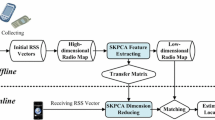Abstract
Location aware computing is popularized and location information use has important due to huge application of mobile computing devices and local area wireless networks. In this paper, we have proposed a method based on Semi-supervised Locally Linear Embedding for indoor wireless networks. Previous methods for location estimation in indoor wireless networks require a large amount of labeled data for learning the radio map. However, labeled instances are often difficult, expensive, or time consuming to obtain, as they require great efforts, meanwhile unlabeled data may be relatively easy to collect. So, the use of semi-supervised learning is more feasible. In the experiment 101 access points (APs) have been deployed so, the RSS vector received by the mobile station has large dimensions (i.e. 101). At first, we use Locally Linear Embedding to reduce the dimensions of data, and then we use semi-supervised learning algorithm to learn the radio map. The algorithm performs nonlinear mapping between the received signal strengths from nearby access points and the user’s location. It is shown that the proposed scheme has the advantage of robustness and scalability, and is easy in training and implementation. In addition, the scheme exhibits superior performance in the nonline-of-sight (NLOS) situation. Experimental results are presented to demonstrate the feasibility of the proposed SSLLE algorithm.
Similar content being viewed by others
References
Ahmad U., Gavrilov A., Lee Y., Lee S. (2008) Context-aware, self-scaling Fuzzy ArtMap for received signal strength based location systems. Soft Computing-A Fusion of Foundations, Methodologies and Applications 12(7): 699–713
Bahl, P., & Padmanabhan, V. (2000). RADAR: An in-building RF-based user location and tracking system. In Proceedings of 19th IEEE annual joint conference of computer and communications societies, INFOCOM 2000 (Vol. 2, pp. 775–784).
Bahl, P., Padmanabhan, V., & Balachandran, A. (2000). Enhancements to the RADAR user location and tracking system. Microsoft Research (MSR-TR-2000-12), 13.
Battiti, R., Nhat, T., & Villani, A. (2002). Location-aware computing: A neural network model for determining location in wireless LANs. Technical Report DIT-02-083, Ingegneria e Scienza dell’Informazione. University of Trento.
Burrell, G., & Kao, D. M. About GPS. http://www.garmin.com/aboutGPS/. Accessed 20 April 2011.
Chen, C. (2005). Hybrid location estimation and tracking system for mobile devices. In Proceedings of 61st IEEE vehicular technology conference, VTC 2005 (Vol. 4, pp. 2648–2652).
Ding, X., Li, H., Li, F., & Wu, J. (2008). A novel infrastructure WLAN locating method based on neural network. In Proceedings of 4th Asian conference on internet engineering (pp. 47–55).
Enge, P., & Misra, P. (1999). Scanning the special issue/technology on the global positioning system. In Proceedings of IEEE, special issue on GPS (Vol. 87, pp. 3–15).
Gupta, A., Tapaswi, S., & Jain, V. (2009). Recurrent grid based voting approach for location estimation in wireless sensor networks. In Proceedings of symposia and workshops on ubiquitous, autonomic and trusted computing, UIC-ATC’09 (pp. 263–267).
Hightower J., Borriello G. (2001) Location systems for ubiquitous computing. Computer 34(8): 57–66
Kashima, H., Suzuki, S., Hido, S., Tsuboi, Y., Takahashi, T., Ide, T. et al. (2007). A semi-supervised approach to indoor location estimation. http://www.geocities.co.jp/Technopolis/5893/publication/ICDMDMC2007-1.pdf. Accessed 20 April 2011.
Krishnan, P., Krishnakumar, A., Ju, W. H., Mallows, C., & Gamt, S. (2004). A system for lease: Location estimation assisted by stationary emitters for indoor rf wireless networks. In Proceedings of 23rd IEEE annual joint conference of computer and communications societies, INFOCOM 2004 (Vol. 2, pp. 1001–1011). doi:10.1109/INFCOM.2004.1356987.
Liu H., Darabi H., Banerjee P., Liu J. (2007) Survey of wireless indoor positioning techniques and systems. IEEE Transactions on Systems, Man, and Cybernetics, Part C: Applications and Reviews 37(6): 1067–1080
Pahlavan K., Li X., Makela J. (2002) Indoor geolocation science and technology. IEEE Communications Magazine 40(2): 112–118. doi:10.1109/35.983917
Roweis S. T., Saul L. K. (2000) Nonlinear dimensionality reduction by locally linear embedding. Science 290(5500): 2323–2326. doi:10.1126/science.290.5500.2323
Saul L. K., Roweis S. T. (2003) Think globally, fit locally: Unsupervised learning of low dimensional manifolds. The Journal of Machine Learning Research 4: 119–155
Yang, Q., Pan, S. J., & Zang, V. W. (2007). IEEE ICDM data mining contest 2007. http://www.cse.ust.hk/~qyang/ICDMDMC07/. Accessed 20 April 2011.
Yang Q., Pan S., Zheng V. (2008) Estimating location using wi-fi. IEEE Intelligent Systems 23(1): 8–13
Yang B., Xu J., Yang J., Li M. (2010) Localization algorithm in wireless sensor networks based on semi-supervised manifold learning and its application. Cluster Computing 13(4): 435–446
Yin J., Hu D., Zhou Z. (2007) Growing locally linear embedding for manifold learning. Journal of Pattern Recognition Research 2(1): 1–16
Youssef, M., & Agrawala, A. (2004). Handling samples correlation in the horus system. In Proceedings of 23rd IEEE annual joint conference of computer and communications societies, INFOCOM 2004 (pp. 1023–1031).
Youssef M., Agrawala A. (2008) The Horus location determination system. Wireless Networks 14(3): 357–374
Author information
Authors and Affiliations
Corresponding author
Rights and permissions
About this article
Cite this article
Jain, V.K., Tapaswi, S. & Shukla, A. Location Estimation Based on Semi-Supervised Locally Linear Embedding (SSLLE) Approach for Indoor Wireless Networks. Wireless Pers Commun 67, 879–893 (2012). https://doi.org/10.1007/s11277-011-0416-2
Published:
Issue Date:
DOI: https://doi.org/10.1007/s11277-011-0416-2




